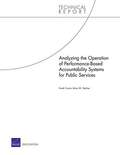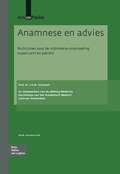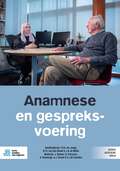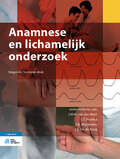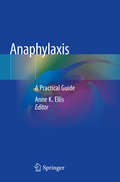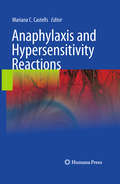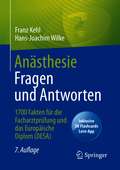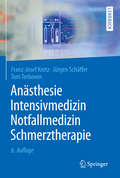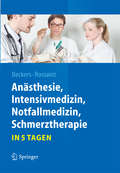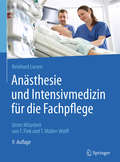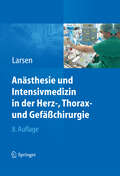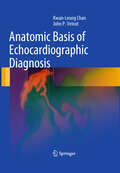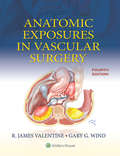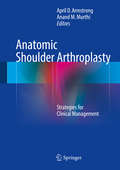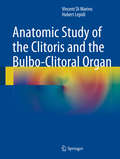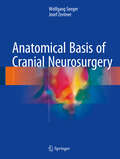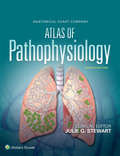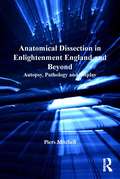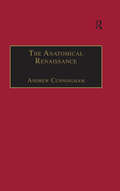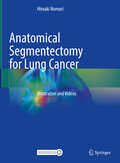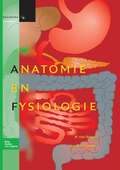- Table View
- List View
Analyzing the Operation of Performance-Based Accountability Systems for Public Services
by Brian M. Stecher Frank CammThis report describes a framework used to organize available empirical information on one form of performance-based management, a performance-based accountability system (PBAS), which identifies individuals or organizations that must change their behavior to improve an activity's performance, an incentive structure to motivate those changes, and measures tailored to inform the incentive structure.
Anamnese en advies: Richtlijnen voor de informatie-uitwisseling tussen arts en patient
by J. A. M. SchoutenDe informatie-uitwisseling tussen arts en patiënt schiet nogal eens tekort, met nadelige consequenties voor de kwaliteit van de medische zorg tot gevolg. Diagnosen worden onjuist of te laat gesteld, verwijzingen zijn overbodig of behandeladviezen worden niet opgevolgd door ontevredenheid van patienten. Anamnese en advies, richtlijnen voor de informatie-uitwisseling tussen arts en patient is geschreven om een bijdrage te kunnen leveren aan de verbetering van de informatieuitwisseling tussen arts en patiënt. Deze informatie-uitwisseling heeft betrekking op het gesprek tussen arts en patient, zoals zich dat afspeelt in het consult van de patient bij de huisarts, in het bezoek van de patient aan de specialistische polikliniek, en in de vele -soms incidentele- contacten met artsen en specialisten tijdens het verblijf van de patiënt in het ziekenhuis. In deze derde, herziene druk van Anamnese en advies zijn herzieningen aangebracht op die punten waar de aard van de gespreksvoering veranderd is ten gevolge van recente ontwikkelingen in de geneeskunde en de maatschappij. Te denken valt hierbij aan de zogenaamde 'mondige' patiënten en de verbreiding van medische kennis onder de bevolking. Nieuw is ook het laatste hoofdstuk, waarin in het aanbevolen gespreksmodel in verband wordt gebracht met de vraag: 'Wat is eigenlijk de grondhouding waarmee de arts zijn beroep wil uitoefenen?'.
Anamnese en gespreksvoering
by T.O.H. de Jongh N. Th. van den Broek J.A. de Wilde J. Damen† R. Franssen A. Kaemingk A. J. Kooter G.J.M. RoodbolEen zorgvuldige anamnese blijft de grondslag van de medische diagnostiek. Tijdens het afnemen van een anamnese moet je je bewust zijn van de aard en het doel van het vraagproces. Met Anamnese en gespreksvoering leer je hoe je een gestructureerde anamnese afneemt op basis van het Calgary-Cambridge model, en hoe je effectieve gesprekken voert met patiënten. Naast het medisch diagnostisch spoor speelt ook het patiëntenperspectief een belangrijke rol. Wat wil jouw patiënt met het gesprek bereiken, hoe ervaart hij zijn klachten? Anamnese en gespreksvoering komt voort uit het Leerboek anamnese en is volledig herzien en uitgebreid.Ook verschillende anamnesevormen zoals klachtgerichte anamnese, hypothesegestuurde anamnese en tractusanamnese worden besproken.Voor de bruikbaarheid in de praktijk worden hierbij veel voorbeelden van anamnesevragen gegeven met de betekenis van de mogelijke antwoorden. Ook lees je achtergrondinformatieover de patiënt, dearts en hun behandelrelatie, gespreksvaardigheden en verschillende consultmodellen. Tot slot is in deze herziening veel aandacht voor andere vormen van gespreksvoering zoals gezondheidsgerichte gesprekken, motiverende gespreksvoering en informerende gesprekken.Bij dit boek hoort een website. Hierop staan behalve de inhoud van dit boek ook een aantal videoconsulten, met voorbeelden van anamnese afnemen en enkele gespreksfragmenten in de praktijk. Anamnese en gespreksvoering is een praktische en onmisbare gids voor medische studenten, verpleegkundig specialisten en physician assistants in opleiding die een goede, patiëntgerichte, diagnostische anamnese willen afnemen en hun gespreksvoering willen verbeteren. Ook artsen en andere medische hulpverleners kunnen met dit boek hun anamnesevaardigheid en gespreksvoering verbeteren.
Anamnese en lichamelijk onderzoek
by J.W.M Meer J. Meer G. Linthorst C. T. Postma D. BlockmansAnamnese en lichamelijk onderzoek is een handleiding voor het onderzoek van pati#65533;nten die op een afdeling voor inwendige geneeskunde worden opgenomen of naar een polikliniek worden verwezen. Het boek is allereerst bedoeld voor studenten in de eerste fase van de opleiding en voor coassistenten inwendige geneeskunde. De nadruk ligt dan ook op problemen die in de kliniek frequent worden aangetroffen. Anamnese en lichamelijk onderzoek is hierdoor eveneens zeer geschikt voor huisartsen en specialisten in opleiding, maar ook voor verpleegkundig specialisten en physician assistants in opleiding. Het boek is rijkelijk ge#65533;llustreerd met kleurenfoto's, tekeningen en tabellen. Een waardevolle aanvulling is de online leeromgeving op www. studiecloud. nl. StudieCloud biedt extra informatie zoals oefenvragen en samenvattingen bij elk hoofdstuk en deeplinks naar relevante artikelen, geluidsfragmenten, films en foto's. Op film ziet men bijvoorbeeld de uitvoering van percussie, auscultatie en meting van de centraalveneuze druk, alsmede onderdelen van het lichamelijk onderzoek die belangrijke informatie opleveren maar veel aandacht en oefening vereisen.
Anamnese en lichamelijk onderzoek
by C. T. Postma J.W.M. van der Meer D. E. Blockmans S.E.J.A. de RooijDit leerboek geeft studenten geneeskunde en coassistenten de kennis en vaardigheden die ze nodig hebben voor het afnemen van een anamnese en uitvoeren van lichamelijk onderzoek. Dit is onontbeerlijk om tot een diagnose te komen en een behandeling in te stellen. Anamnese en lichamelijk onderzoek richt zich primair op patiënten met internistische aandoeningen. Toch is het niet alleen zeer geschikt voor specialisten in opleiding maar ook voor huisartsen, verpleegkundig specialisten en physician assistants in opleiding.Anamnese en lichamelijk onderzoek bespreekt systematisch en bondig de differentiaaldiagnose van veelvoorkomende klachten en bevindingen bij onderzoek. Ook wordt er ingegaan op de verslaglegging die daarbij hoort. Het boek is rijk geïllustreerd met kleurenfoto’s, tekeningen en tabellen. Daarnaast is er een uitgebreide onlineleeromgeving met aanvullende informatie. Hierin staan bij elk hoofdstuk samenvattingen en oefenvragen én links naar artikelen, geluidsfragmenten, films en foto’s. In deze films is bijvoorbeeld de uitvoering van percussie, auscultatie en palpatie te zien. Net als belangrijke onderdelen van het lichamelijk onderzoek die veel aandacht en oefening vereisen. De redactie en de auteurs van het boek zijn afkomstig uit de universitaire medische centra in Nederland en België.
Anamnese en lichamelijk onderzoek van hart en perifere arteriën
by J.P.M Hamer P. G. Pieper R.B.A. BrinkEen patiënt met een mogelijke hart- of vaatziekte heeft belang bij een zorgvuldige anamnese als uitgangspunt voor de juiste diagnose en behandeling. Het lichamelijk onderzoek gaat daarbij hand in hand met het anamnestische gesprek. Dit onderzoek dreigde in de laatste jaren echter in het gedrang te komen door de populariteit van (beeldvormende) diagnostische technieken. Inmiddels zien velen weer in dat de bruikbaarheid van aanvullende technieken wordt bepaald door de juiste indicatie, gebaseerd op een gerichte anamnese. De auteurs, allen met ruime ervaring in het medische onderwijs, behandelen op systematische wijze de anamnese en het lichamelijk onderzoek. Zij benadrukken in dit rijk geïllustreerde handboek de voorspellende waarde van zowel anamnestische gegevens als bevindingen bij het lichamelijk onderzoek. De opgenomen fonocardiogrammen onderbouwen de waarde van auscultatie. De lezer wordt gewezen op gangbare fouten en misvattingen bij bloeddrukmeting. Meting van de centraalveneuze druk, door velen moeilijk gevonden, wordt in detail behandeld en met schema's en foto's ondersteund. Het boek verwijst naar webpagina's over auscultatie en lichamelijk onderzoek. Achtergrondinformatie wordt als kadertekst aangeboden, zodat de lezer voor meer of minder informatie kan kiezen. Anamnese en lichamelijk onderzoek van hart en perifere arteriën ondersteunt de dagelijkse praktijk van studenten, coassistenten, arts-assistenten in uiteenlopende specialismen, cardiologen, huisartsen, physician-assistants en anderen die werkzaam zijn in de zorgsector en belangstelling hebben voor de diagnostiek van harten vaatziekten.
Anaphylaxis: A Practical Guide
by Anne K. EllisThis book serves as a comprehensive but concise, practical, in-depth resource for practitioners who see and treat anaphylaxis. It meets the market need for a reference that relays an advanced understanding of the condition and its management. This unique reference covers management beyond the basics, including discussions around prevention of biphasic anaphylaxis, optimal post-stabilization protocols and how to work up intraoperative anaphylaxis. Additionally, various chapters delve into the practical application of equipping one’s office for the management of anaphylaxis, specifically in the setting of a reaction to a food challenge or immunotherapy injection. Anaphylaxis: A Practical Guide is an essential resource for allergists, emergency room physicians, and pediatricians, and those in training to become members of these specialties.
Anaphylaxis and Hypersensitivity Reactions
by Mariana C. CastellsDespite wide recognition as a serious public health problem, anaphylaxis and hypersensitivity reactions remain under-recognized and under-diagnosed. This book fills the gaps in our understanding of the identification of triggers, recognition of clinical presentations, understanding of the natural history of these reactions, and selection of treatment strategies including those focused on cellular and molecular targets. The book provides a detailed examination of disease etiology, pathogenesis, and pathophysiology and their correlation to clinical practice. Forefront knowledge of the mediators and mechanisms of anaphylaxis is covered with an emphasis on how new discoveries shape our current and emerging therapies.
Anästhesie Fragen und Antworten: 1700 Fakten für die Facharztprüfung und das Europäische Diplom (DESA)
by Franz Kehl Hans-Joachim WilkeDieses bewährte Buch für Weiterbildungsassistenten in der Anästhesie ist der Garant für eine effektive Vorbereitung auf die Prüfung zum Facharzt sowie auf das Europäische Diplom für Anästhesiologie und Intensivmedizin (DESA). Mit 340 Multiple-Choice-Fragen nach dem Prüfungsprinzip der D.E.A.A kombiniert mit kommentierten richtigen wie falschen Antworten können Sie Ihr Wissen gezielt überprüfen. Verbunden mit dem guten Preis-Leistungs-Verhältnis eine bewährte Vorbereitung für alle Weiterbildungsassistenten in der Anästhesie; auch für Wiedereinsteiger ideal, um das Fachwissen gezielt aufzufrischen.Die 7. Auflage: komplett aktualisiert, um neue Fragen erweitert, im größeren Format plus SN Flashcard App zum Lernen unterwegs
Anästhesie, Intensivmedizin, Notfallmedizin, Schmerztherapie (Springer-Lehrbuch)
by Franz-Josef Kretz Jürgen Schäffer Tom TerbovenÜbersichtlich und kompakt vermittelt Ihnen dieses Lehrbuch die wichtigsten Inhalte aus allen vier AINS-Fächern. Wie intubiere ich einen Patienten? Worauf kommt es bei der Algesiologie an? Hier bekommen Sie das gesamte Wissen, das Sie für die Prüfung brauchen mit einem direkten Praxisbezug.
Anästhesie, Intensivmedizin, Notfallmedizin, Schmerztherapie ... in 5 Tagen: In 5 Tagen (Springer-Lehrbuch)
by Stefan K. Beckers Rolf Rossaint5 Tage gegen schlaflose Nächte Strukturiert und konzentriert bekommen Sie hier die prüfungsrelevante Anästhesie, Intensivmedizin, Notfallmedizin und Schmerztherapie in 5 Tagen. Für alle, die sich kurz vor knapp auf das "Hammerexamen" vorbereiten und während des PJs kaum Zeit haben ist dieses Buch "der Hammer". Die Inhalte sind nach ihrer Häufigkeit in den IMPP-Fragen gewichtet. So können Sie sicher sein, nicht stundenlang Exoten zu lernen, die dann doch nie geprüft werden. Die Texte sind stichpunktartig geschrieben, sinnvolle Tabellen und Hinweise auf Prüfungsfallen und Verwechslungsgefahren ergänzen die Fakten. Platz für eigene Notizen bietet die Randspalte, so können Sie auch ganz spezielle Inhalte für die mündliche Prüfung festhalten. Und natürlich können Sie die Lerneinheiten auch auf eine längere Zeit verteilen. Kürzer und kompakter geht es für die Prüfung nun wirklich nicht.
Anästhesie und Intensivmedizin für die Fachpflege
by Reinhard LarsenIn dem Standard-Lehrbuch „Der Larsen“ finden Sie alle wesentlichen Themen, die Sie für den erfolgreichen Abschluss Ihrer Fachweiterbildung benötigen und die Sie fit für die Praxis auf Intensivstation und im OP machen. Die Inhalte orientieren sich an den Weiterbildungsverordnungen, sind systematisch aufbereitet sowie verständlich und nachvollziehbar erklärt. Viele Tipps für das konkrete Vorgehen am Patienten, aktuelle Internetadressen und ein übersichtliches Glossar machen das Werk besonders praxistauglich.
Anästhesie und Intensivmedizin in Herz-, Thorax- und Gefäßchirurgie
by Reinhard LarsenDer Band bietet eine Anleitung zum anästhesiologischen und intensivmedizinischen Management in der Herz-, Thorax- und Gefäßchirurgie und bereitet Anästhesisten und Intensivmediziner zugleich auf besondere Situationen vor: Vorbereitung des Patienten, intra- und postoperative Überwachung des Patienten, Umgang mit der Herz-Lungen-Maschine, Reaktion auf Komplikationen. Die Inhalte sind klar strukturiert, das Nachschlagewerk bietet zahlreiche Tabellen und Abbildungen sowie Tipps und Tricks aus der Praxis. Die 8. Auflage wurde durchgehend aktualisiert.
Anatomic Basis of Echocardiographic Diagnosis
by John P. Veinot Kwan-Leung ChanThe aim of this book is to provide a systematic approach to echocardiographic diagnosis based upon a comprehensive understanding of cardiac anatomy. We shall provide abundant anatomic correlates of echocardiographic findings throughout the book.The book will be divided into three sections. Each chapter will cover both normal and pathological findings on echocardiography with anatomic correlation. The first section will address the normal findings which can be appreciated by current day echocardiography. The impact of aging on cardiac structure and function will also be covered in this section. In the second section, specific cardiac diseases will be discussed. The differentiating features between normal and pathologic conditions will be discussed. The last section will address specific clinical settings where echocardiography is pivotal for diagnosis and patient management.
Anatomic Basis of Tumor Surgery
by John E. Skandalakis William C. Wood Charles Staley Sean MooreModern biological understanding is the basis for a multimodality treatment of a tumor. 'Anatomic Basis of Tumor Surgery' is the only book that provides an anatomic basis and description of tumor surgery based on an understanding of both the anatomy and biology of tumor progression. It presents the regional anatomy to allow tailoring of the operation as demanded.
Anatomic Exposures in Vascular Surgery
by R. James Valentine Gary G. WindFeaturing more than 550 full-color, 3-dimensional drawings of anatomic exposures for every open vascular procedure you’re likely to perform, Anatomic Exposures in Vascular Surgery, 4th Edition, clearly and uniquely depicts the anatomy the vascular or general surgeon will see in the operating room. In practical detail, it describes and shows the anatomic relationships of blood vessels and surrounding fascia, muscles, and nerves surgeons should be familiar with when operating on the vascular system, as well as how best to approach the vessels through and around those surrounding tissues. Concise, focused text accompanies each drawing on the same page, making information easy to find and digest.
Anatomic, Physiologic, and Therapeutic Principles of Surgical Diseases: A Comprehensive, High-Yield Review
by Benjamin J. Hazen Shishir K. Maithel Ravi R. Rajani Jahnavi SrinivasanComprehensive and high-yield, this text is a digestible resource for the major anatomic, physiologic, and therapeutic principles of surgical diseases. Rather than focus on clinical presentation and pre-operative management, it presents sensible algorithmic approaches to treatment for each pathology, with particular attention to operative options. This allows the reader to develop a large armamentarium of surgical options to safely treat surgical problems and aid in the decision-making process in an organized fashion, with critical steps and techniques of specific operations included in each chapter. Importantly, this book provides a concise list of steps for common surgical operations, namely those frequently encountered during the Certifying Oral Board exam after completing residency, which is uncommon in the currently available study material. Chapters also include suggested readings and summaries of pivotal studies on the specific topics, serving as an easy reference for the content provided. The topics covered begin with pre-operative evaluation and anesthesiology, then proceed anatomically across all relevant body systems and organs, as well as trauma, transplantation, pediatric surgery, and much more.Written with senior-level general surgery residents preparing for the qualifying (written) and certifying (oral) board examinations clearly in mind, it will also be valuable to all levels of trainees preparing for the annual American Board of Surgery In-service Training Exam (ABSITE) as well as medical students with an interest in surgical training and trainees in their fellowship after completing residency.
Anatomic Shoulder Arthroplasty: Strategies for Clinical Management
by April D. D. Armstrong Anand M. M. MurthiOpening with a discussion of the indications and pre-operative evaluation of the arthritic shoulder and a review of the anatomy and biomechanics of the shoulder, this comprehensive clinical guide to anatomic shoulder arthroplasty then proceeds to describe the various types of prosthetics and management techniques used in this common surgical procedure. Humeral head resurfacing is described, along with stemmed and stemless replacements, followed by the anatomy and biomechanics of the glenoid using both standard and augmented replacement. Interposition shoulder arthroplasty, revision total shoulder arthroplasty, and hemiarthroplasty of the proximal humerus are likewise elaborated. Additional chapters on complications -- infection, periprosthetic fracture,subscapularis insufficiency and instability -- and rehabilitation techniques round out the presentation. Anatomic Shoulder Arthroplasty is an excellent resource for orthopeadic and shoulder surgeons and sports medicine practitioners, both new and veteran.
Anatomic Study of the Clitoris and the Bulbo-Clitoral Organ
by Vincent Marino Hubert LepidiThis eagerly awaited book offers a unique, comprehensive scientific study of the anatomy of the organ of female sexual pleasure. The authors use macroscopic and microscopic research to guide the reader from the glans, the visible part of the clitoris, where they explore the impressive sensory corpuscles, to the hidden roots of the bulbo-clitoral organ. They show its complexity, its exact location within the external genitalia and its intimate relationship with the urethro-vaginal pyramid. They also remind us that throughout history there has been a failure to understand this organ and explain that this misunderstanding remains the cause of persistent excisions, criminal mutilating practices that have not yet been eradicated. Using extensive iconography, they demonstrate throughout this book that the bulbo-clitoral organ is an exceptional natural treasure that every woman possesses and that every man should know well.
Anatomical Basis of Cranial Neurosurgery
by Wolfgang Seeger Josef ZentnerThis didactic book clearly and systematically describes the anatomical-surgical fundamentals of cranial neurosurgery, relating them to norm variants, imaging modalities and interdisciplinary aspects. All illustrations, hand drawn in ink by the first author, are simple and self-explanatory. <P><P> The book reflects the first author’s lifetime experience as an academic neurosurgeon and teacher, as well as the second author’s theoretical and practical knowledge of neurosurgical subspecialties such as epilepsy surgery. <P> In addition to its core audience in neurosurgery, it provides all connected disciplines, in particular neuroradiology, neurology, neuropathology, ENT surgery, maxillofacial surgery and eye surgery, with unique anatomical insights into the neurosurgeon’s perspective.
Anatomical Chart Company Atlas of Pathophysiology
by Julie StewartComprehensive and practical, the freshly updated Anatomical Chart Company Atlas of Pathophysiology, 4th Edition, offers nearly 450 illustrations that demonstrate the causes, symptoms, and progression of more than 200 disorders. Clear and simple explanations of each disorder are followed by rationales for proven clinical interventions. This backup to classroom texts is also a handy on-the-unit reference for nurses and other healthcare professionals, and support for patient education. At-a-glance answers—and the right interventions—for more than 200 disorders in a quick-read format … NEW includes a free eBook NEW and updated content illustrating and explaining the most common conditions, with topics presented alphabetically: Central concepts—cells, cancer, infection, genetics, and fluids and electrolytes Disorders affecting each body system—respiratory, neurologic, gastrointestinal, musculoskeletal, hematologic, immunologic, endocrine, and reproductive—as well as renal, skin, and sensory disorders Each disease entry presents an introduction, causes, pathophysiology, complications, signs and symptoms, diagnostic test results, and treatment, with facing page showing a detailed illustration to help you visualize the disease process Easy-to-locate content in an easy-read template that tackles numerous topics found in daily practice, such as: Diseases and disorders that need immediate attention, such as pulmonary embolism, depression, and glaucoma The differences between prehypertension and Stage 1 hypertension Which parts of the brain are affected by generalized seizures, as opposed to partial seizures Lifestyle changes to recommend to a patient with high plasma glucose The causes of carpel tunnel syndrome 450 large, detailed, full-color illustrations from Anatomical Chart Company to help you differentiate among symptoms and disorders that appear similar Icons that offer important tips, including: Age Alert – how pathophysiologic processes—incidence, onset, and clinical appearance—appear in different age groups, such as aortic aneurysm, atypical myocardial infarction, and Parkinson’s disease Clinical Tips – advice on areas such as improving auscultation in myocarditis, evaluating diagnostic test results in suspected spinal injuries, early recognition of life-threatening symptoms in myasthenia gravis, respiration changes in peritonitis, and more Complications – identifies common progressions of untreated or worsening conditions
Anatomical Dissection in Enlightenment England and Beyond: Autopsy, Pathology and Display (The\history Of Medicine In Context Ser.)
by Piers MitchellExcavations of medical school and workhouse cemeteries undertaken in Britain in the last decade have unearthed fascinating new evidence for the way that bodies were dissected or autopsied in the eighteenth and nineteenth centuries. This book brings together the latest discoveries by these biological anthropologists, alongside experts in the early history of pathology museums in British medical schools and the Royal College of Surgeons of England, and medical historians studying the social context of dissection and autopsy in the Georgian and Victorian periods. Together they reveal a previously unknown view of the practice of anatomical dissection and the role of museums in this period, in parallel with the attitudes of the general population to the study of human anatomy in the Enlightenment.
The Anatomical Renaissance: The Resurrection of the Anatomical Projects of the Ancients
by Andrew CunninghamThe central proposition of this book is that the great anatomists of the Renaissance, from Vesalius to Fabricius and Harvey - the forebears of modern scientific biology and medicine - consciously resurrected not merely the methods but also the research projects of Aristotle and other Ancients. The Moderns' choice of topics and subjects, their aims, and their evaluation of their investigations were all made in a spirit of emulation, not rejection, of their distant predecessors. First published in 1997, Andrew Cunningham’s masterly analysis of the history of the ’scientific renaissance' - a history not of things found, but of projects of enquiry - provoked a reappraisal of the intellectual roots of the Renaissance as well as illuminating debates on the history of the body and its images.
Anatomical Segmentectomy for Lung Cancer: Illustration and Videos
by Hiroaki NomoriThis book explains more than 30 types of segmentectomy with plentiful figures to explain the intraoperative findings and anatomy of the lung. It also provides videos to help readers recognize the tricks and techniques that are not explained in still images. The book is organized into four parts following the anatomy of the lung; right upper lobe, right lower lobe, left upper lobe, and left lower lobe. Each chapter goes into detail on each segment and offers the latest devices and procedures. Although segmentectomy is known as curative surgery for early-stage small lung cancers, not many surgeons can perform with accuracy due to its anatomical complexity. Therefore, the purpose of Anatomical Segmentectomy for Lung Cancer is to share the knowledge and experiences of performing the surgeries and to further enhance the techniques by creating a foundation for building on to this knowledge. It is a valuable resource for thoracic surgeons interested in curative surgery for small lung cancers and for those who wish to stay up to date on the latest techniques.
Anatomie en fysiologie: Niveau 3 (Basiswerken Verpleging en Verzorging)
by N. HalemDit boek bevat alle basiskennis van anatomie en fysiologie die verzorgenden nodig hebben om hun beroep goed uit te kunnen oefenen. Kennis over het menselijk lichaam en inzicht in het functioneren ervan zijn belangrijke voorwaarden om op een veilige manier zorg te kunnen verlenen.Met Anatomie en fysiologie hebben verzorgenden een prettig leesbaar en logisch geordend boek in handen. De afbeeldingen en duidelijke tekst zorgen er voor dat leerlingen de theorie makkelijk eigen kunnen maken en verbanden leren begrijpen.In dit boek worden de verschillende orgaansystemen behandeld. Omdat de bouw - en functie van het lichaam sterk met elkaar samenhangen, komen beide steeds in elk hoofdstuk aan bod. Ook wordt er een duidelijke relatie gelegd tussen de fysiologie en ziekteverschijnselen. Hoe kunnen verzorgenden ziekteverschijnselen die zij zien, verklaren vanuit de anatomie en fysiologie? In elk hoofdstuk wordt in aparte kaders (in de rubriek In de praktijk) een aantal verschijnselen vanuit de fysiologie verklaard, bijvoorbeeld bij het hoofdstuk Spijsvertering: braken, geelzucht, obstipatie en diarree. Bij het hoofdstuk Huid: jeuk en bij hoofdstuk Zenuwstelsel wordt een verband gelegd tussen de anatomie en uitvalsverschijnselen.Zoveel mogelijk Nederlandse termen worden gebruikt, soms aangevuld met de meest voorkomende Latijnse namen. Achter in het basiswerk is een verklarende woordenlijst latijn-nederlands opgenomen, zodat leerlingen het altijd kunnen opzoeken.
